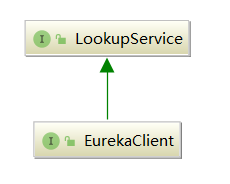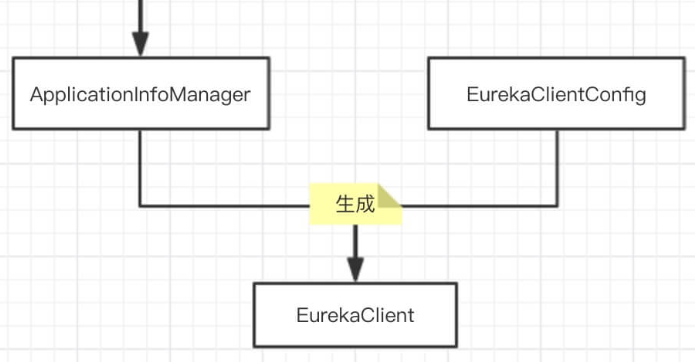Eureka-Server注册中心启动时,会构造一个EurakaClient对象:
eurekaClient = new DiscoveryClient(applicationInfoManager, eurekaClientConfig);
EurakaClient对象的主要作用如下:
- 提供多种方法获取应用集合(
com.netflix.discovery.shared.Applications) 和 应用实例(com.netflix.appinfo.InstanceInfo); - 提供方法获取本地客户端信息,例如,应用管理器(
com.netflix.appinfo.ApplicationInfoManager)和 Eureka-Client 配置(com.netflix.discovery.EurekaClientConfig); - 提供方法注册本地客户端的健康检查和 Eureka 事件监听器。

LookupService,顾名思义,是查找服务,这个接口提供了一些 简单单一 的方式获取应用集合(
com.netflix.discovery.shared.Applications) 和 应用实例信息(com.netflix.appinfo.InstanceInfo)。
一、DiscoveryClient
DiscoveryClient是EurakaClient的具体实现,用于与 Eureka-Server 交互,它在构造时需要ApplicationInfoManager对象和EurekaClientConfig对象:

DiscoveryClient提供了如下功能:
- 向 Eureka-Server 注册 自身服务;
- 向 Eureka-Server 续约 自身服务;
- 向 Eureka-Server 取消 自身服务;
- 从 Eureka-Server 查询 应用集合和应用实例信息。
1.1 构造
DiscoveryClient对象的构造最终是调用了如下构造器,大家可以先顺着我的注释了解整个流程:
// Applications 在Eureka-Client本地的缓存
private final AtomicReference<Applications> localRegionApps = new AtomicReference<Applications>();
// 拉取注册表次数
private final AtomicLong fetchRegistryGeneration;
// 最后一次成功拉取注册表的时间戳
private volatile long lastSuccessfulRegistryFetchTimestamp = -1;
// 最后一次成功发送心跳(续约)的时间戳
private volatile long lastSuccessfulHeartbeatTimestamp = -1;
// 心跳(续约)的监控
private final ThresholdLevelsMetric heartbeatStalenessMonitor;
// 注册表拉取的监控
private final ThresholdLevelsMetric registryStalenessMonitor;
DiscoveryClient(ApplicationInfoManager applicationInfoManager, EurekaClientConfig config, AbstractDiscoveryClientOptionalArgs args, Provider<BackupRegistry> backupRegistryProvider) {
// 注:BackupRegistry是备份注册表接口,没有具体实现;
// AbstractDiscoveryClientOptionalArgs是可选参数抽象基类,这两个都可以忽略
// 1.设置各种健康检查处理器、监听器
if (args != null) {
this.healthCheckHandlerProvider = args.healthCheckHandlerProvider;
this.healthCheckCallbackProvider = args.healthCheckCallbackProvider;
// Eureka 事件监听器
this.eventListeners.addAll(args.getEventListeners());
this.preRegistrationHandler = args.preRegistrationHandler;
} else {
this.healthCheckCallbackProvider = null;
this.healthCheckHandlerProvider = null;
this.preRegistrationHandler = null;
}
// 2.将ApplicationInfoManager、EurekaClientConfig、InstanceInfo保存到自身的字段中
this.applicationInfoManager = applicationInfoManager;
InstanceInfo myInfo = applicationInfoManager.getInfo();
clientConfig = config;
staticClientConfig = clientConfig;
transportConfig = config.getTransportConfig();
// 设置当前应用实例对象
instanceInfo = myInfo;
if (myInfo != null) {
// 无实际用途,用于打印logger
appPathIdentifier = instanceInfo.getAppName() + "/" + instanceInfo.getId();
} else {
logger.warn("Setting instanceInfo to a passed in null value");
}
// 设置备份注册表,目前没有默认实现,忽略
this.backupRegistryProvider = backupRegistryProvider;
this.urlRandomizer = new EndpointUtils.InstanceInfoBasedUrlRandomizer(instanceInfo);
// 3.设置Applications在本地的缓存,后续定时任务间隔从 Eureka-Server 拉取注册实例信息到本地缓存
localRegionApps.set(new Applications());
// 拉取注册表的次数
fetchRegistryGeneration = new AtomicLong(0);
// 获取哪些区域( Region )集合的注册信息
remoteRegionsToFetch = new AtomicReference<String>(clientConfig.fetchRegistryForRemoteRegions());
// 获取哪些区域( Region )集合的注册信息
remoteRegionsRef = new AtomicReference<>(remoteRegionsToFetch.get() == null ? null : remoteRegionsToFetch.get().split(","));
// 4.设置是否拉取注册表
if (config.shouldFetchRegistry()) {
this.registryStalenessMonitor = new ThresholdLevelsMetric(this, METRIC_REGISTRY_PREFIX + "lastUpdateSec_", new long[]{15L, 30L, 60L, 120L, 240L, 480L});
} else {
this.registryStalenessMonitor = ThresholdLevelsMetric.NO_OP_METRIC;
}
// 5.设置是否向注册中心注册自身
if (config.shouldRegisterWithEureka()) {
this.heartbeatStalenessMonitor = new ThresholdLevelsMetric(this, METRIC_REGISTRATION_PREFIX + "lastHeartbeatSec_", new long[]{15L, 30L, 60L, 120L, 240L, 480L});
} else {
this.heartbeatStalenessMonitor = ThresholdLevelsMetric.NO_OP_METRIC;
}
logger.info("Initializing Eureka in region {}", clientConfig.getRegion());
// 6.如果当前应用实例是单体部署,也就是既不向注册中心注册,也不拉取注册表
if (!config.shouldRegisterWithEureka() && !config.shouldFetchRegistry()) {
logger.info("Client configured to neither register nor query for data.");
scheduler = null;
heartbeatExecutor = null;
cacheRefreshExecutor = null;
eurekaTransport = null;
instanceRegionChecker = new InstanceRegionChecker(new PropertyBasedAzToRegionMapper(config), clientConfig.getRegion());
// This is a bit of hack to allow for existing code using DiscoveryManager.getInstance()
// to work with DI'd DiscoveryClient
DiscoveryManager.getInstance().setDiscoveryClient(this);
DiscoveryManager.getInstance().setEurekaClientConfig(config);
initTimestampMs = System.currentTimeMillis();
logger.info("Discovery Client initialized at timestamp {} with initial instances count: {}",
initTimestampMs, this.getApplications().size());
// 直接返回,不需要启动任何调度任务
return;
}
try {
// 7.创建一个支持定时调度任务的线程池
scheduler = Executors.newScheduledThreadPool(2,
new ThreadFactoryBuilder()
.setNameFormat("DiscoveryClient-%d")
.setDaemon(true)
.build());
// 8.创建一个用于发送心跳(续约)的线程池,注意这里用了SynchronousQueue,且keepAliveTime=0,
// 那么当线程数量达到maxsize时,由于SynchronousQueue没有空间,所以非核心线程会直接退出
heartbeatExecutor = new ThreadPoolExecutor(
1, clientConfig.getHeartbeatExecutorThreadPoolSize(), 0, TimeUnit.SECONDS,
new SynchronousQueue<Runnable>(),
new ThreadFactoryBuilder()
.setNameFormat("DiscoveryClient-HeartbeatExecutor-%d")
.setDaemon(true)
.build()
);
// 9.创建一个支持本地注册表缓存刷新的线程池
cacheRefreshExecutor = new ThreadPoolExecutor(
1, clientConfig.getCacheRefreshExecutorThreadPoolSize(), 0, TimeUnit.SECONDS,
new SynchronousQueue<Runnable>(),
new ThreadFactoryBuilder()
.setNameFormat("DiscoveryClient-CacheRefreshExecutor-%d")
.setDaemon(true)
.build()
);
// 10.创建一个支持eureka client跟eureka server进行网络通信的底层组件
eurekaTransport = new EurekaTransport();
scheduleServerEndpointTask(eurekaTransport, args);
// 忽略AWS相关逻辑...
} catch (Throwable e) {
throw new RuntimeException("Failed to initialize DiscoveryClient!", e);
}
// 11.如果配置了需要拉取注册表,则这里就会进行初始拉取
if (clientConfig.shouldFetchRegistry() && !fetchRegistry(false)) {
// 拉取失败则从备份注册表拉取,没有具体实现,无意义
fetchRegistryFromBackup();
}
// 12.执行注册前的预处理
if (this.preRegistrationHandler != null) {
this.preRegistrationHandler.beforeRegistration();
}
// 15.启动调度任务
initScheduledTasks();
try {
// 向 Netflix Servo 注册监控,可忽略
Monitors.registerObject(this);
} catch (Throwable e) {
logger.warn("Cannot register timers", e);
}
//...
// 初始化完成时间戳
initTimestampMs = System.currentTimeMillis();
logger.info("Discovery Client initialized at timestamp {} with initial instances count: {}",
initTimestampMs, this.getApplications().size());
}
上述DiscoveryClient的构造流程, 核心其实就三点:
- 根据应用实例信息和客户端配置信息,设置DiscoveryClient对象自身的各种属性;
- 初始化两个定时任务涉及的线程池: 拉取注册表定时任务 、 心跳(续租)定时任务 ;
- 向线程池中提交任务,开始周期性的进行注册表拉取和心跳。
后续章节,我会详细讲解服务注册和发现,本章我们先掌握整体流程。
1.2 任务调度
本节,我们来重点看下initScheduledTasks方法,其实就是启动了与Eureka-Client相关的所有调度任务:
private InstanceInfoReplicator instanceInfoReplicator;
private void initScheduledTasks() {
// 1.需要拉取注册表
if (clientConfig.shouldFetchRegistry()) {
// 客户端拉取注册表的间隔,默认30s
int registryFetchIntervalSeconds = clientConfig.getRegistryFetchIntervalSeconds();
// 拉取注册表超时重试延期最大因子
int expBackOffBound = clientConfig.getCacheRefreshExecutorExponentialBackOffBound();
// 开始调度任务
scheduler.schedule(
new TimedSupervisorTask(
"cacheRefresh",
scheduler,
cacheRefreshExecutor,
registryFetchIntervalSeconds,
TimeUnit.SECONDS,
expBackOffBound,
new CacheRefreshThread()
),
registryFetchIntervalSeconds, TimeUnit.SECONDS);
}
// 2.需要向注册中心注册
if (clientConfig.shouldRegisterWithEureka()) {
// 心跳间隔,默认30s
int renewalIntervalInSecs = instanceInfo.getLeaseInfo().getRenewalIntervalInSecs();
// 心跳超时重试延期最大因子
int expBackOffBound = clientConfig.getHeartbeatExecutorExponentialBackOffBound();
logger.info("Starting heartbeat executor: " + "renew interval is: " + renewalIntervalInSecs);
// 开始调度任务
scheduler.schedule(
new TimedSupervisorTask(
"heartbeat",
scheduler,
heartbeatExecutor,
renewalIntervalInSecs,
TimeUnit.SECONDS,
expBackOffBound,
new HeartbeatThread()
),
renewalIntervalInSecs, TimeUnit.SECONDS);
// 创建一个应用实例副本传播器,用于Eureka集群之间的数据同步
instanceInfoReplicator = new InstanceInfoReplicator(
this,
instanceInfo,
clientConfig.getInstanceInfoReplicationIntervalSeconds(),
2); // burstSize
// 应用实例状态表更监听器,用于监听应用实例的状态变更事件
statusChangeListener = new ApplicationInfoManager.StatusChangeListener() {
@Override
public String getId() {
return "statusChangeListener";
}
@Override
public void notify(StatusChangeEvent statusChangeEvent) {
if (InstanceStatus.DOWN == statusChangeEvent.getStatus() ||
InstanceStatus.DOWN == statusChangeEvent.getPreviousStatus()) {
// log at warn level if DOWN was involved
logger.warn("Saw local status change event {}", statusChangeEvent);
} else {
logger.info("Saw local status change event {}", statusChangeEvent);
}
instanceInfoReplicator.onDemandUpdate();
}
};
if (clientConfig.shouldOnDemandUpdateStatusChange()) {
applicationInfoManager.registerStatusChangeListener(statusChangeListener);
}
// 3.开始调度
instanceInfoReplicator.start(clientConfig.getInitialInstanceInfoReplicationIntervalSeconds());
} else {
logger.info("Not registering with Eureka server per configuration");
}
}
上述方法核心一共启动了三个调度任务,并增加了一个监听器:
- Eureka-Client周期性地拉取Eureka-Server的注册表;
- Eureka-Client周期性向Eureka-Server发送心跳;
- 应用实例副本传播器InstanceInfoReplicator,会定时进行Eureka集群间的应用实例信息同步;
- 监听对应用实例状态的变更事件。
二、总结
本章,我讲解了EurekaClient的构造和初始化过程,虽然从代码上看挺复杂的,但是整体流程还是非常清晰的,就是配置EurekaClient实例对象需要的各种属性,然后创建一些线程池,最后开始定时任务的调度。
EurekaClient初始化过程中的核心是它内部的那些调度任务:包括拉取注册表、心跳续约等等,这些我会在后续章节分别一一讲解。
Java 面试宝典是大明哥全力打造的 Java 精品面试题,它是一份靠谱、强大、详细、经典的 Java 后端面试宝典。它不仅仅只是一道道面试题,而是一套完整的 Java 知识体系,一套你 Java 知识点的扫盲贴。
它的内容包括:
- 大厂真题:Java 面试宝典里面的题目都是最近几年的高频的大厂面试真题。
- 原创内容:Java 面试宝典内容全部都是大明哥原创,内容全面且通俗易懂,回答部分可以直接作为面试回答内容。
- 持续更新:一次购买,永久有效。大明哥会持续更新 3+ 年,累计更新 1000+,宝典会不断迭代更新,保证最新、最全面。
- 覆盖全面:本宝典累计更新 1000+,从 Java 入门到 Java 架构的高频面试题,实现 360° 全覆盖。
- 不止面试:内容包含面试题解析、内容详解、知识扩展,它不仅仅只是一份面试题,更是一套完整的 Java 知识体系。
- 宝典详情:https://www.yuque.com/chenssy/sike-java/xvlo920axlp7sf4k
- 宝典总览:https://www.yuque.com/chenssy/sike-java/yogsehzntzgp4ly1
- 宝典进展:https://www.yuque.com/chenssy/sike-java/en9ned7loo47z5aw
目前 Java 面试宝典累计更新 400+ 道,总字数 42w+。大明哥还在持续更新中,下图是大明哥在 2024-12 月份的更新情况:

想了解详情的小伙伴,扫描下面二维码加大明哥微信【daming091】咨询

同时,大明哥也整理一套目前市面最常见的热点面试题。微信搜[大明哥聊 Java]或扫描下方二维码关注大明哥的原创公众号[大明哥聊 Java] ,回复【面试题】 即可免费领取。

